Yersinia pseudotuberculosis disseminates directly from a replicating bacterial pool in the intestine
- PMID: 16754724
- PMCID: PMC2118325
- DOI: 10.1084/jem.20060905
Yersinia pseudotuberculosis disseminates directly from a replicating bacterial pool in the intestine
Erratum in
- J Exp Med. 2006 Jul 10;203(7):1829
Abstract
Dissemination of Yersinia pseudotuberculosis within mice after oral inoculation was analyzed. Y. pseudotuberculosis translocated to organs such as the liver and spleen shortly after oral inoculation, but was quickly cleared. In contrast, a second temporally distinct bacterial translocation event resulted in successful hepatosplenic replication of the bacteria. Replicating pools of bacteria could be established in these organs in mouse mutants that lacked Peyer's patches. These animals frequently had sterile mesenteric lymph nodes, a finding consistent with translocation taking place independently of regional lymph node colonization. In further contradiction to accepted models for dissemination of enteropathogens, clonal analysis revealed that bacteria causing disease in the spleen and liver of C57BL/6J mice were derived from populations located outside the intestinal lymph nodes. Replication of bacteria in the intestine before translocation appeared critical for dissemination, as transient selective suppression by streptomycin of bacterial growth in the intestine delayed dissemination of Y. pseudotuberculosis. These results collectively indicate that hepatosplenic colonization appears intimately connected with the ability of Y. pseudotuberculosis to successfully establish replication in the intestinal lumen and does not result from ordered spread leading from the intestine to regional lymph nodes before dissemination.
Figures
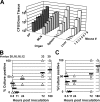
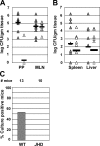
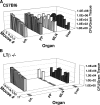

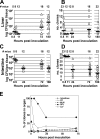
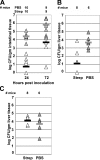
References
-
- Naktin, J., and K.G. Beavis. 1999. Yersinia enterocolitica and Yersinia pseudotuberculosis. Clin. Lab. Med. 19:523–536. - PubMed
-
- Bottone, E.J. 1999. Yersinia enterocolitica: overview and epidemiologic correlates. Microbes Infect. 1:323–333. - PubMed
-
- Hubbert, W.T., C.W. Petenyi, L.A. Glasgow, C.T. Uyeda, and S.A. Creighton. 1971. Yersinia pseudotuberculosis infection in the United States. Septicema, appendicitis, and mesenteric lymphadenitis. Am. J. Trop. Med. Hyg. 20:679–684. - PubMed
Publication types
MeSH terms
Grants and funding
LinkOut - more resources
Full Text Sources
Other Literature Sources
Molecular Biology Databases

